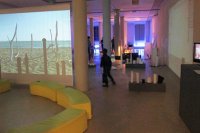The “Reggio Approach” to 0-99 Education: Redefining Schools as Community Learning Centers
Your content has been saved!
Go to My Saved Content.This is the second post in a two-part series. For the first part, please see The "Reggio Approach" to 0-99 Education: A Deep Exploration of Community.
In Carla Rinaldi's keynote speech from the 2013 Winter Institute in Reggio Emilia, Italy, perhaps the thread with the deepest roots was the redefinition of "school" as a community learning center. Once again, Rinaldi foreshadowed what attendees would see in action in Reggio schools throughout the week:
That’s an incredible statement . . . and mission. I’ve sent that passage from Rinaldi’s speech to many, and find myself rereading it again and again in the weeks that have passed since attending the conference.
The LMIC itself, where this international conference is hosted, is a spectacle of minimalist, modern design. Open and collaborative spaces that display the explorations of children to understand their world are decorated in glass, light, sculpted furniture and a simple color palette. Many rooms in the LMIC are actually "community learning spaces" where children and families are invited in to share in explorations.
Building off the collaborative spaces and programs in the LMIC, each school we visited had many programs in place that welcomed families to explore student work. Parents and guardians were invited in to understand their children's developmental phases of learning and to understand how to ask questions that promote learning at home. All the while in these schools, the work of children is consistently on display.
The entire town of Reggio Emilia occasionally takes on the mission as well. On one conference night, the town was transformed into a "Night of Storytelling." Many of these bards and troubadours offered simple tales from memory or read stories. Some tales became nothing short of stage productions incorporating light, sound, music and costumes. Understanding very little of the Italian language myself, I spent most of the time watching those who listened in the audience. By all the faces I saw, everyone loved it.
To Boldly Go: System and Individual Approaches to Take Away
By Rinaldi's account, as successful as these educators are at building great teaching practice and reshaping the schools as a community learning centers, they are just getting started. She said:
Of course, it’s hard to judge if the Reggio Approach is perfect. I don’t think perfect exists in something as dynamic as education. That’s the nature of an exploration of continuity and research; we must keep making adjustments. What Loris Malaguzzi did, along with those that have worked with him, was take a stance on creating something they thought would work, something that made sense. They have adjusted over time rather than remaining stagnant. It’s something different from the status quo of the industrialized approach to education which so many feel is no longer meeting students' needs or encouraging them to reach their potential.
Major shifts in school structures can be difficult and intensely bureaucratic, a product of cognitive dissonance. A look into the Reggio Approach opens up ideas on some simple things we could do differently in an educational system, in a school, or even in an individual classroom. Who knows what some small shifts might set in motion?
Do you or could you:
- Share your lesson plans with peers to gain an outside perspective?
- Design your learning spaces to promote student collaboration?
- Promote a culture of inquiry in your classroom? Do students "do" or "listen" more?
- Incorporate art and making things (drawing, building, design thinking and visual literacy) into your work with students? If not, why?
- Open up your classroom and your students' work to parents -- and perhaps the community?
I didn’t even begin to explain how teachers and Atelieristas (artists in residence) in the Reggio system relentlessly document student work and learning through a variety of means. That could easily be a series of articles in itself. If you’re interested, two books can help you down that path: The Hundred Languages of Children: The Reggio Emilia Experience in Transformation, and Making Learning Visible: Children as Individuals and Group Learners.
I can only describe my time at the Winter Institute and in Reggio Emilia as better than I could have hoped for. Despite studying the Reggio Approach for all these years, I found being at the conference and seeing it all in action incredibly refreshing. I'll be headed back to Reggio Emilia and the LMIC in April to continue discussions with these inspiring educators.
What's Next
I'm off to explore the rich culture and educational models of nine schools in New Zealand. In the meantime, I’d love to hear about your thoughts on the Reggio Approach and any favorite programs you’ve encountered promoting student engagement around the world. Please share them in the comments area below.
